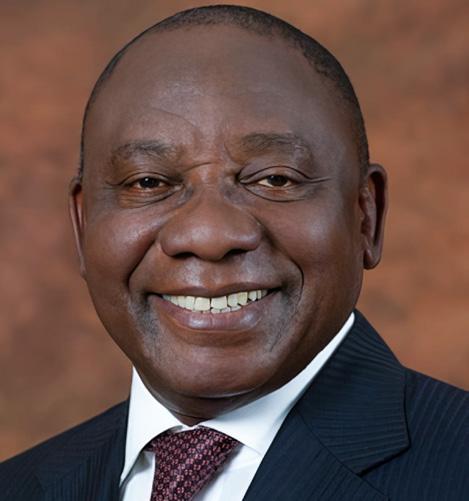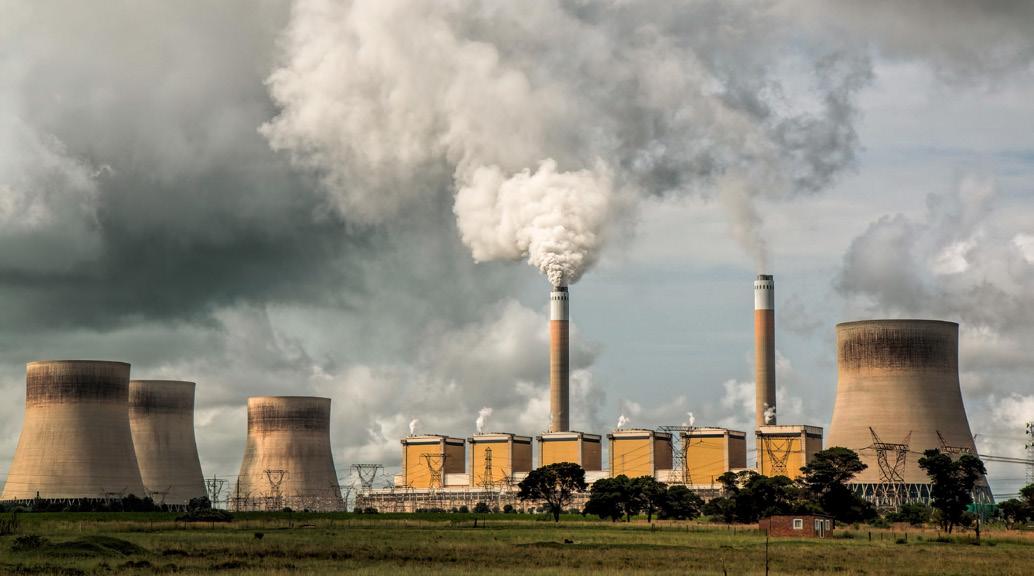
7 minute read
I
In July 2022, President Ramaphosa announced a clear action plan to address the energy crisis. This was to address the electricity shortfall of 4 000 to 6 000 megawatts (MW). The plan outlined five key interventions to:
• Fix Eskom’s coal-fired power stations and improve the availability of existing supply.
• Enable and accelerate private investment in generation capacity.
• Accelerate procurement of new capacity from renewables, gas and battery storage.
• Unleash businesses and households to invest in rooftop solar.
• Fundamentally transform the electricity sector to achieve longterm energy security.
Experts agree that this plan is the most realistic route to end loadshedding. Since then, government has made important progress in implementing the plan.
ESKOM’S PERFORMANCE
Government has taken steps to improve the performance of Eskom’s existing power stations so that the coal-fired power stations that provide 80% of electricity produce the amount of electricity for which they were designed. Under its new board, Eskom is deploying people and resources to improve the reliability of the six power stations that have contributed the most to loadshedding.
Eskom is urgently fast-tracking construction of a temporary solution to bring back three units at Kusile Power Station following the collapse of a chimney stack last year, while simultaneously repairing the permanent structure.
Government is rebuilding the skills that have been lost and have already recruited skilled personnel at senior levels to be deployed at underperforming power stations. The Engineering Council of South Africa has offered to give as much assistance as required by deploying engineers to work with the management teams at power stations.
National Treasury is finalising a solution to Eskom’s R400-billion debt burden in a manner that is equitable and fair to all stakeholders, which will enable the utility to make necessary investments in maintenance and transmission. Government will support Eskom to secure additional funding to purchase diesel for the rest of the financial year. This should reduce the severity of loadshedding as Eskom will be able to use its diesel-run plants when the system is under strain.
Eskom has launched a programme to buy excess power from private generators and has already secured 300MW from neighbouring countries.
Corruption And Theft
The South African Police Service (SAPS) has established a dedicated team with senior leadership to deal with the pervasive corruption and theft at several power stations that has contributed to the poor performance of these stations. Intelligence-driven operations at Eskom-related sites have so far resulted in 43 arrests.
Restructuring Eskom
As part of the broader reform process, the restructuring of Eskom that government previously announced is proceeding and the National Transmission Company will soon be operational with an independent board.
Later this year, government will table the Electricity Regulation Amendment Bill to transform the energy sector and establish a competitive electricity market.
Solar Power
As indicated in July last year, and with a view to addressing the loadshedding crisis, government is going to proceed with the rollout of rooftop solar panels. In his Budget Speech [upcoming at time of press], the Minister of Finance will outline how households will be assisted and how businesses will be able to benefit from a tax incentive.
National Treasury is working on adjustments to the Bounce-back Loan Scheme to help small businesses invest in solar equipment, and to allow banks and development finance institutions to borrow directly from the scheme to facilitate the leasing of solar panels to their customers.
New Electricity Capacity
One of the potent reforms government has embarked upon is to allow private developers to generate electricity. There are now more than 100 projects, which are expected to provide over 9 000MW of new capacity over time.
A few companies that have participated in the renewable energy programme will soon enter construction and deliver a total of
“In
2 800MW of new capacity. Eskom will procure emergency power that can be deployed within six months to close the immediate gap. Government is investing in new transmission lines and substations, especially in areas such as the Eastern Cape, Northern Cape and Western Cape. All these measures will result in a massive increase in power to the grid over the next 12 to 18 months, and beyond.
This power will be in line with the diverse mix of energy sources, including the current coal-fired power stations, solar, wind, gas, nuclear, hydro and battery storage. To fully implement this plan, government needs strong central coordination and decisive action.
National State Of Disaster
The National Disaster Management Centre has consequently classified the energy crisis and its impact as a disaster. Government is, therefore, declaring a National State of Disaster to respond to the electricity crisis and its effects. The Minister of Cooperative Governance and Traditional Affairs has gazetted the declaration of the State of Disaster, which began with immediate effect.
The State of Disaster will enable government to provide practical measures that it needs to take to support businesses in the food production, storage and retail supply chain, including for the roll-out of generators, solar panels and uninterrupted power supply. Where technically possible, it will enable government to exempt critical infrastructure such as hospitals and water treatment plants from loadshedding. It will also help government to accelerate energy projects and limit regulatory requirements while maintaining rigorous environmental protections, procurement principles and technical standards. The Auditor-General will be brought in to ensure continuous monitoring of expenditure, to guard against any abuses of the funds needed to attend to this disaster.

“The process of restructuring government will give us an opportunity to determine the positioning of various areas of responsibilities and how best the various ministries and departments can best serve our national objectives. We are focusing our attention on the energy crisis right now and will address the restructuring of government in due course.”
President Cyril Ramaphosa, SoNA, 9 February 2023.
Minister Of Electricity In The Presidency
This is necessary because an effective response to this crisis involves several different departments and entities that require coordination from the centre of government. Government will be including other social partners in an effective structure like the one it set up to drive the vaccine rollout. Extraordinary circumstances call for extraordinary measures.
The energy crisis is an existential threat to the economy and social fabric. Government must spare no effort, and it must allow no delay, in implementing these measures. As it takes these actions to resolve the energy crisis, government is mindful of the risks that climate change poses to society.

Climate Change
Extreme weather events in the form of drought, floods and wildfires increasingly pose a risk to the health, wellbeing and safety of people. Government will continue its just transition to a low-carbon economy at a pace the country can afford and in a manner that ensures energy security. Government will undertake the just transition in a way that opens the possibility of new investments, new industrialisation and that, above all, creates new jobs. The Presidential Climate Commission is guiding much of this work, and, in doing so, building a new model for inclusive and collective decision-making, incorporating the individuals, workers and communities that are most affected in the transition.
Just Energy Transition Investment Plan
Through the Just Energy Transition Investment Plan (JET-IP), R1.5-trillion will be invested in the economy over the next five years in new frontiers such as renewable energy, green hydrogen and electric vehicles. Several projects are already underway, including the development of a new facility by Sasol at Boegoebaai in the Northern Cape, the Prieska Power Reserve in the Free State, and the Hydrogen Valley initiative in Limpopo, Gauteng and KwaZulu-Natal.
The Northern Cape has already attracted well over R100-billion in investments in renewable energy projects. These and other massive investments in renewable energy will create jobs and stimulate local economies not only in the Northern Cape, but also in the Eastern Cape, Western Cape and Mpumalanga, turning even the most arid desert into a giant energy source. Above all, the just transition will prioritise workers and communities in vulnerable industries to ensure that no one is left behind. S
Fibre is about more than just connecting to the Internet, says Zoom Fibre’s managing director Mohamed Asmal, in reference to the exciting new smart poles that have been installed in various sites in the Saldanha Bay Municipality.
“Fibre is about unleashing the power of a digital future and we are doing this right now in the Saldanha Bay Municipality, and we will take these learnings and apply them to other regions where Zoom Fibre has coverage,” says Asmal.
Zoom Fibre, which as part of the Baobab Project alongside its partners, the Saldanha Bay Municipality and Amoeba TSC, took on the task of managing the infrastructure –namely the fibre network – that would power the country’s first truly smart city. Zoom Fibre, whose Western Cape staff contingent is based in Vredenburg, is well-known to residents in the region having laid fibre in towns across the region.
“I want you to imagine this,” says Asmal. “Imagine smart poles that run off their own renewable energy with a brain so powerful that they can adjust their brightness if there is no-one in the streets, they can proactively reduce crime and reactively lead to the capture and arrest of criminals, manage traffic volumes, provide WiFi hotspots and so much more. That is the immense power of fibre and that is why we wake up every morning at Zoom Fibre: to bring the power of fibre to the people and to drive real digital inclusion and transformation, and so as we work through this proof of concept with the first batch of towers, over time and as it becomes feasible, we will increase the scope and functionality of the smart towers and eventually unleash the full power of fibre.”
Asmal says that while the current phase in Saldanha Bay Municipality (SBM) is a pilot, or a proof of concept, the idea is to roll out the smart poles across the entire municipality and eventually in other regions of the country. “We foresee smart poles wherever Zoom Fibre has a fibre network that can enable them,” he says.
Beyond working towards the ability to recognise faces and people without capturing personal information, and therefore link suspects to a crime, the smart poles – such as the ones in the SBM region – would eventually have the functionality to be able to be proactive, such as raise alerts if suspicious people were seen gathering in the vicinity of a business or school, for example, and deploy security and alert the police.








